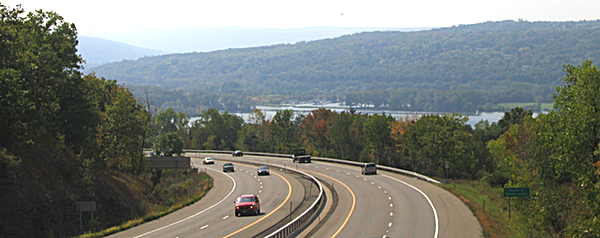- By NYS DOT
- Around Town
 Print
Print 
Officials from the State Department of Transportation, State Thruway Authority, State Police and the Governor's Traffic Safety Committee kicked off the 18th annual work zone safety week by reminding motorists to slow down and drive carefully through highway work zones. National Work Zone Awareness Week is April 3 through 7.
"Highway maintenance and construction workers are on the road every day making sure we can get to where we need to go," State Department of Transportation Commissioner Matthew J. Driscoll said. "Drivers must pay extra attention in highway work zones and take every precaution to keep themselves, other travelers and highway workers safe so that everyone can go home at the end of the day."
Many factors contribute to work zone accidents, including speeding, cell phone use and inattentive, distracted or aggressive driving. All of these behaviors are discouraged when driving on any road, but they can be especially dangerous in work zones. The most common type of accidents in work zones are rear-end collisions, so it is important that drivers maintain adequate following distances.
NYSDOT reported 662 crashes in capital construction work zones on state roads and bridges in 2016, resulting in 6 motorist fatalities and 187 injuries to motorists, contractor employees and NYSDOT staff. There were 10 injuries and one fatality in maintenance work zones last year.
In addition, drivers last year intruded into closed portions of highway construction work zones 92 times and maintenance work zones 84 times, endangering themselves, their passengers, highway workers and other travelers.
The New York State Thruway Authority reported 132 work zone-related accidents and zero work zone fatalities on the Thruway for the first half of 2016. This is a 6.4 percent decrease for the same time period in 2015. Thruway Authority Acting Executive Director Bill Finch said, "With construction season about to begin, National Work Zone Safety Awareness Week serves as an opportune moment to remind motorists to be extra vigilant when driving through a work zone. Day-in and day-out, our dedicated crews are working to keep the Thruway safe for the traveling public and I implore drivers to slow down, move over and abide by the posted work zone speed limit so that we can continue to make the Thruway one of the safest superhighways in the country." In New York State, fines are doubled for speeding in a work zone. In accordance with the Work Zone Safety Act of 2005, convictions of two or more speeding violations in a work zone could result in the suspension of an individual's driver's license. Superintendent George P. Beach II said, "The New York State Police are committed to keeping our roadways safe for those who travel them, and for the individuals who work on them. As construction season begins, we want to remind drivers to be mindful of the workers and equipment in work zones. Drivers can do their part to keep those in our work zones safe by obeying posted speed limits, staying alert and putting their electronic devices away. Safety is a priority and our Troopers will be vigilant in enforcing the rules of the road and violators will be ticketed."
DMV Executive Deputy Commissioner and Acting Chair of the Governor's Traffic Safety Committee Terri Egan said, "Highway work zones are hazardous, not only for workers but for motorists as well, which is why fines for speeding are doubled even when workers aren't present. I urge every motorist to be patient, slow down, keep a safe distance from the vehicle in front of you and avoid distractions when traveling through work zones. The temporary inconvenience of construction is far outweighed by protecting workers and the improved safety of having well-maintained roadways."
National Work Zone Awareness Week is designated by the Federal Highway Administration to raise driver awareness and reduce the number of vehicle intrusions into work zones, incidents that can cause injuries and fatalities.
This year's safety campaign theme, "Work Zone Safety is in Your Hands," highlights motorists' responsibility to be alert and act safely while in and around work zones, where driving conditions can vary. Highway work zones often have reduced speed limits, closed or shifted traffic lanes and people working on or near the road, making it that much more important for motorists to be aware of their surroundings.
New York State works continually to improve safety and best practices within highway work zones. Safety measures include reducing speed limits in work zones and performing highway work at off-peak hours, when traffic is at a minimum. Others include flagging operations and the use of concrete barriers, bright orange cones and barrels to separate traffic from work space, highly reflective sheeting on orange work zone signs and rumble strips to alert motorists to road conditions.
Technology is also used to enable motorists to avoid work zones by taking alternate routes, including electronic highway message signs that give advanced warning of work zones, highway advisory radio frequencies that broadcast work zone information, and 511ny.org, which provides real-time information on travel conditions.
Governor Cuomo in 2012 announced the 'Drivers First' initiative to prioritize the convenience of motorists and ensure that disruptions are as minimal as possible to drivers at highway and bridge work zones across the state. While some delays are unavoidable, the initiative has helped to minimize traffic congestion and travel delays due to road and bridge work.
The Governor also signed the "Move Over" law, which requires drivers to use due care, slow down and safely move over when approaching law enforcement vehicles, fire trucks, ambulances, tow trucks, construction and maintenance vehicles stopped along the roadway. The law, established in 2011 and expanded since, is designed to give law enforcement, emergency services and highway workers room to do their jobs safely.
v13i14



